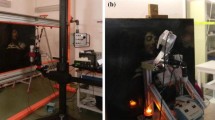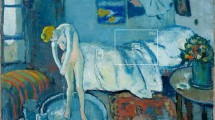Abstract
A portrait of Henry VIII on oak panel c. 1535 has recently undergone technical examination to inform questions regarding authorship and the painting’s relationship to a group of similar works in the collections of the National Portrait Gallery, London, and the Society of Antiquaries. Due to previous conservation treatments of the painting, the conventional transmission X-radiograph image was difficult to interpret. As a result, the painting underwent high-definition X-ray fluorescence (XRF) elemental mapping on the X-ray fluorescence microscopy beamline of the Australian Synchrotron. Scans were conducted at 12.6 and 18.5 keV, below and above the lead (Pb) L edges, respectively. Typical scan parameters were 120 μm pixel size at 7 ms dwell time, with the largest scan covering an area 545 × 287 mm2 collected in 23 h (10.8 MP). XRF mapping of the panel has guided the conservation treatment of the painting and the revelation of previously obscured features. It has also provided insight into the process of making of the painting. The informative and detailed elemental maps, alongside ultra-high-definition scans of the painting undertaken before and after varnish and over-paint removal, have assisted in comparison of the finely painted details with the London paintings. The resolution offered by the combination of imaging techniques identifies pigment distribution at an extremely fine scale, enabling a new understanding of the artist’s paint application.












Similar content being viewed by others
Notes
These emerging techniques of digital exploration of objects have profound implications for museological interpretive strategies, offering a shift from formal didactic methodologies to affective, sensory, dialogic and self-driven visitor experiences. See Witcomb [21]. Examples of the successful development of interpretive narratives from ultra-high-resolution scanning can be seen in two interactive systems produced by the Applied Laboratory for Interactive Visualization and Embodiment (ALiVE), City University of Hong Kong, from the scanning of one of the treasures from the collection of the Hong Kong Maritime Museum, Pacifying the South China Sea, an eighteen-metre-long nineteenth-century silk scroll. The first system immersed the viewer in a 360° environment, 10 m across 4.5 m high. As the scroll rotates around the screen, 55 animations reconstruct the narratives in an unfurling sequence. The second featured a 42-in. 4K scrolling screen that allows users to pan and zoom the image in great depth, where part of the screen displays historical texts related to the painting, dynamically revealed as the user zooms in and around the image. An important consideration was that the approaches taken respected the mode of viewing originally intended of the object. See Kenderdine [22].
References
R. Strong, The English Renaissance Miniature (Thames and Hudson, London, 1983), p. 44
C. Bolland, T. Cooper, The Real Tudors Kings and Queens Rediscovered (National Portrait Gallery, London, 2014), p. 9
National Portrait Gallery, Making art in Tudor Britain (National Portrait Gallery, London 2015). http://www.npg.org.uk/research/programmes/making-art-in-tudor-britain.php. Accessed 10 Feb 2015
K.J. Van den Berg, K. Kuene, S. De Groot, H. Van Keulen, I.D. Van der Werf, A. Burnstock, in ICOM-CC Preprints 17th Triennial Conference (Melbourne, 2014)
J. Dik, K. Janssens, G. Van der Snickt, L. Van der Loeff, K. Rickers, M. Cotte, Anal. Chem. 80, 16 (2008)
M. Alfeld, J.A.C. Broekaert, Spectrochim. Acta Part B 88, 211 (2013)
U. Bergmann, P.L. Manning, R.A. Wogelius, Annu. Rev. Anal. Chem. 5, 361 (2012)
K. Janssens, M. Alfeld, G. Van der Snickt, W. De Nolf, F. Vanmeert, M. Radepont, L. Monico, J. Dik, M. Cotte, G. Falkenberg, C. Miliani, B.G. Brunetti, Annu. Rev. Anal. Chem. 6, 399 (2013)
D. Paterson, M.D. de Jonge, D.L. Howard, W. Lewis, J. McKinlay, A. Starritt, M. Kusel, C.G. Ryan, R. Kirkham, G. Moorhead, D. Siddons, AIP Conf. Proc. 1365, 219 (2011)
C.G. Ryan, D.P. Siddons, R. Kirkham, Z.Y. Li, M.D. de Jonge, D.J. Paterson, A. Kuczewski, D.L. Howard, P.A. Dunn, G. Falkenberg, U. Boesenberg, G. De Geronimo, L.A. Fisher, A. Halfpenny, M.J. Lintern, E. Lombi, K.A. Dyl, M. Jensen, G.F. Moorhead, J.S. Cleverley, R.M. Hough, B. Godel, S.J. Barnes, S.A. James, K.M. Spiers, M. Alfeld, G. Wellenreuther, Z. Vukmanovic, S. Borg, J. Phys. Conf. Ser. 499, 012002 (2014)
L. Bertrand, S. Schöeder, D. Anglos, M.B.H. Breese, K. Janssens, M. Moini, A. Simon, Mitigation strategies for radiation damage in the analysis of ancient materials. TrAC. 66 (2015), pp. 3278–3286
C.G. Ryan, Int. J. Imaging Syst. Technol. 11, 219 (2000)
C.G. Ryan, D.R. Cousens, S.H. Sie, W.L. Griffin, G.F. Suter, E. Clayton, Nucl. Instrum. Methods Phys. Res. B 47, 55 (1990)
D.L. Howard, M.D. de Jonge, D. Lau, D. Hay, M. Varcoe-Cocks, C.G. Ryan, R. Kirkham, G. Moorhead, D. Paterson, D. Thurrowgood, Anal. Chem. 84 (2012), pp. 128–145
P. Nobel, A. Van Loon, G. Van de Snict, K. Janssens, M. Alfeld, J. Dik, in ICOM-CC Preprints 17th Triennial Conference (Melbourne, 2014)
National Portrait Gallery, Tudor and Jacobean portrait database. (National Portrait Gallery, London 2015). http://www.npg.org.uk/collections/search/portraitConservation/mw03084/King-Henry-VIII? Accessed 11 Feb 2015
R.D. Harley, Artists’ pigments c. 1600–1835, 2nd edn. (Butterworths, London, 1982), p. 85
M. Lintern, R. Anand, C. Ryan, D. Paterson, Nat. Commun. 4, 2614 (2013)
A. Lins, Basic Properties of Gold Leaf, Gilded Wood, Conservation and History (Sound View Press, Connecticut, 1991), p. 20
K. Fukunaga, M. Picollo, Appl. Phys. A 100, 591 (2010)
A. Witcomb, in Theorizing Digital Cultural Heritage: A Critical Discourse, ed. by F. Cameron, S. Kenderdine (MIT Press, Cambridge, 2006), pp. 35–48
S. Kenderdine, Orientations 44, 3 (2013)
Acknowledgments
The conservation and technical examination of Portrait of Henry VIII was funded through the generous contributions of Len Groat, Ken Reed, Hamish Parker, Friends of Conservation and a gift in memory of the late Dorothy R. Spry. Part of this research was carried out on the X-ray fluorescence microscopy beamline at the Australian Synchrotron, Clayton, Victoria, Australia. Access to the Australian Synchrotron was supported under the NSW Industry Synchrotron Access Scheme, funded by the NSW State Government Office of Science and Research. In addition, the authors are grateful to Gillian Osmond, Queensland Art Gallery, and Malgorzata Sawicki, Art Gallery of New South Wales for their comments.
Author information
Authors and Affiliations
Corresponding author
Rights and permissions
About this article
Cite this article
Dredge, P., Ives, S., Howard, D.L. et al. Mapping Henry: Synchrotron-sourced X-ray fluorescence mapping and ultra-high-definition scanning of an early Tudor portrait of Henry VIII. Appl. Phys. A 121, 789–800 (2015). https://doi.org/10.1007/s00339-015-9455-y
Received:
Accepted:
Published:
Issue Date:
DOI: https://doi.org/10.1007/s00339-015-9455-y




